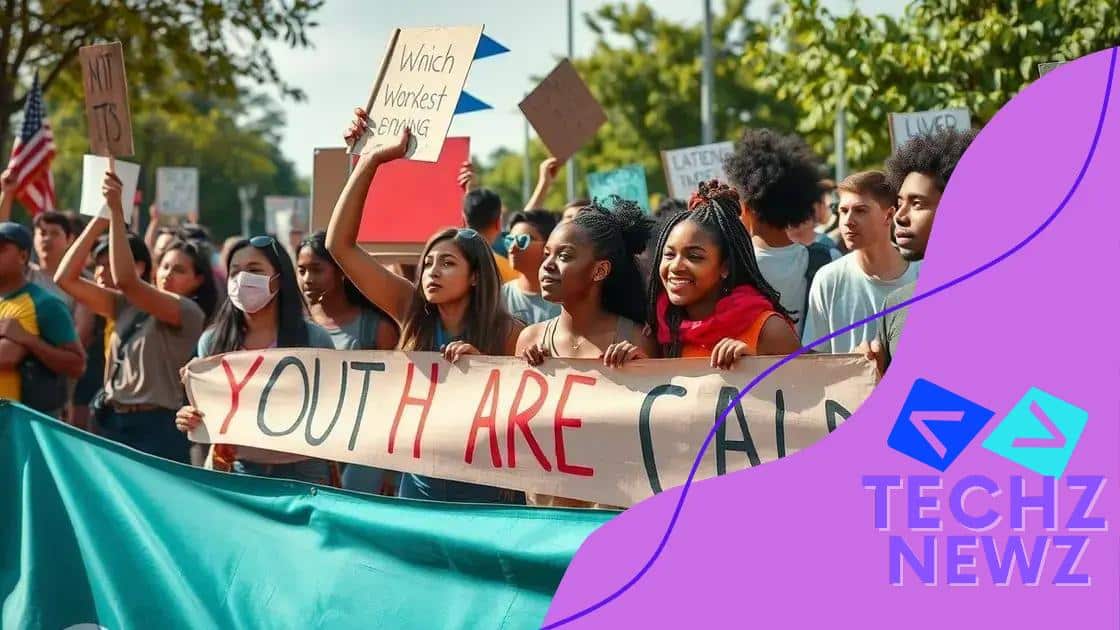Social media’s influence on youth activism

Social media’s influence on youth activism empowers young people to connect globally, share their messages, and effectively mobilize for change while facing challenges like online harassment and misinformation.
Social media’s influence on youth activism is reshaping the landscape of social justice, empowering young people to engage and mobilize like never before. How are platforms driving this change? Let’s dive in.
The rise of youth activism
In recent years, there has been a remarkable shift in how young people approach activism. Youth activism has gained momentum, largely fueled by social media and the desire for change. Today, more than ever, young voices are being amplified, encouraging participation in various causes.
Understanding the Rise of Youth Activism
One reason for this surge is the accessibility of information. Young people can learn about issues quickly and share their thoughts on platforms like Instagram, Twitter, and TikTok. Each platform offers unique ways to connect with others, raising awareness around critical topics.
Key Factors Driving Youth Activism
- Social media reach: Allows youth to communicate with a broader audience.
- Effective storytelling: Engages emotions and promotes greater understanding.
- Community building: Fosters solidarity among young activists.
- Influential figures: Public figures and peers inspire action through their platforms.
Moreover, young activists are not just reacting but are proposing solutions. Campaigns often highlight environmental issues, social justice, and equality. This proactive stance is essential in creating genuine impact. Young voices are becoming increasingly important in shaping conversations and movements.
Additionally, schools and universities are becoming hubs for activism. Young people organize events, protests, and workshops to spread their messages. This involvement nurtures a sense of responsibility and fosters a culture of engagement. Grassroots movements often start on campuses, setting the groundwork for national attention. Many activists are using their creativity to design compelling visual content that can be shared widely.
The rise of youth activism is exciting, showcasing how digital tools can foster important conversations. The combination of passion, creativity, and strategy paints a bright future for this movement. Empowered by platforms that promote their messages, youth are stepping up like never before.
How social media amplifies voices
Social media plays a crucial role in amplifying the voices of youth activists. Often, it serves as the primary platform for spreading messages and organizing movements. With the click of a button, young people can share their stories and connect with others who feel the same way.
The Power of Hashtags
Hashtags are essential tools that help unify campaigns. They simplify the process of finding information about a cause. For example, movements like #BlackLivesMatter and #FridaysForFuture demonstrate how a simple hashtag can gather support and spark global conversations.
Visual Storytelling
Images and videos are powerful ways to communicate effectively. Visual content can stir emotions and capture attention quickly. Activists often use memes, infographics, and personal stories to engage a wider audience. This form of storytelling can lead to greater empathy and understanding.
- Engagement: Posts with visuals receive more shares and comments.
- Accessibility: Visuals break down complex issues into digestible content.
- Emotional Impact: Images evoke feelings that words alone may not.
- Virality: Compelling visuals can quickly go viral, reaching millions.
Moreover, social media enables real-time updates about ongoing campaigns. Activists can inform followers instantly, rally support, and share successes. This immediacy is key to maintaining momentum in movements.
Not only is social media a platform for spreading awareness, but it also fosters community. Young activists feel less isolated when they find like-minded individuals online. This sense of belonging encourages further involvement and action. By sharing their experiences, young people empower each other and create a supportive network for change.
Case studies of successful campaigns

Examining case studies of successful campaigns reveals how youth activism has effectively addressed critical issues. These campaigns showcase the power of collective action fueled by passion and social media.
Examples of Impactful Campaigns
One notable example is the March for Our Lives movement, initiated by students following the tragic shooting at Marjory Stoneman Douglas High School in 2018. This campaign effectively organized nationwide marches, advocating for stricter gun control laws. Through social media, students shared their experiences and mobilized supporters, drawing attention to this national crisis.
Greta Thunberg and Fridays for Future
Another significant campaign is led by Greta Thunberg. Starting with a solitary protest outside the Swedish parliament, Greta inspired millions to join her for Fridays for Future, advocating for urgent climate action. This global movement demonstrated how one person’s voice could ignite a worldwide call for change.
- Mass mobilization: Large crowds gathered globally, showing solidarity.
- Media engagement: The campaign gained traction by drawing media attention.
- Youth-led initiatives: Young activists took the lead in planning and executing events.
- Collaborations: Partnerships with organizations strengthened their message.
These case studies highlight another crucial aspect: storytelling. Both campaigns used powerful narratives to connect emotionally with the audience. By sharing personal stories, activists appealed to others’ senses of empathy, which is essential for driving change.
Additionally, success is often linked to the ability to adapt strategies. Youth activists frequently assess their approaches and refine them based on feedback and outcomes. For instance, the use of innovative marketing, such as viral videos and eye-catching graphics, has played a pivotal role in reaching a broader audience.
Challenges youth activists face online
Youth activists encounter various challenges when speaking out online. Although social media amplifies their voices, it also creates hurdles. These challenges can hinder their ability to effectively advocate for change.
Navigating Online Harassment
One major issue is online harassment. Activists, especially those from marginalized communities, often face threats and bullying. This negative attention can make it difficult for them to share their messages or engage in discussions. Many young activists report feeling unsafe or silenced as a result.
Disinformation and Misinformation
Another challenge is the spread of disinformation and misinformation. False narratives can derail genuine movements. Activists must work hard to debunk lies and clarify their messages. This often takes time and resources that could be better spent on activism itself.
- Fact-checking: Activists need to verify information before sharing.
- Education: They often engage their audience to help distinguish fact from fiction.
- Building trust: Establishing credibility is essential to counter misinformation.
Additionally, algorithms on social media platforms can limit visibility. Youth activists may struggle to reach a broader audience if their posts do not align with trending topics. This makes it harder to garner support for less popular causes. Activists must constantly adapt their strategies to navigate these changing landscapes.
Finally, the emotional toll of activism can be significant. Constant engagement with difficult issues can lead to burnout. Many young people balance this work with school, jobs, and personal lives. Therefore, prioritizing mental health is crucial for sustaining their efforts.
The future of activism in the digital age
The future of activism in the digital age looks promising and dynamic. As technology continues to evolve, it offers new tools for young activists to amplify their messages. These advancements create opportunities for a more engaged and informed public.
Emerging Technologies
One key aspect of the future is the use of emerging technologies, such as artificial intelligence and virtual reality. These technologies can enhance storytelling and create immersive experiences. For instance, virtual reality can transport users to the front lines of a cause, making issues feel more immediate and real.
Global Connectivity
Furthermore, the internet enables activists to connect globally. Issues that might seem local can spark international movements. With social media, a young activist in one part of the world can share their story, inspiring others to join in from another. This global connectivity solidifies a united front for various causes.
- Collaboration: Activists can form partnerships across borders.
- Resource sharing: Knowledge and tools can be shared quickly and easily.
- Movement-building: Global events can grow larger and mobilize diverse groups of people.
Additionally, online platforms are becoming safer for activists. Tech companies recognize the importance of protecting user privacy and combating harassment. Enhanced security features will encourage more young people to participate and express themselves freely.
In this ever-growing digital landscape, young activists must also prioritize digital literacy. Understanding how to navigate online spaces, avoid misinformation, and engage audiences effectively is essential. Education in these areas will empower the next generation of activists to make a real impact.
Ultimately, the future of activism will likely lead to more innovative campaigns that will resonate with diverse audiences. As technology advances, the potential for creative and powerful activism will only grow.
FAQ – Questions about youth activism in the digital age
How does social media help youth activism?
Social media amplifies youth voices, allowing them to share their messages and connect with others globally to support various causes.
What challenges do young activists face online?
Young activists face challenges such as online harassment, misinformation, and issues with visibility due to social media algorithms.
What role do emerging technologies play in activism?
Emerging technologies like AI and virtual reality enhance storytelling and create immersive experiences, making activism more engaging.
How can young activists protect themselves online?
They can use privacy settings, report harassment, and engage in digital literacy education to navigate online spaces safely.





